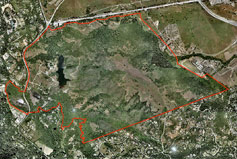
Handy Links
SLAC News Center
SLAC Today
- Subscribe
- Archives: Feb 2006-May 20, 2011
- Archives: May 23, 2011 and later
- Submit Feedback or Story Ideas
- About SLAC Today
SLAC News
Lab News
- Interactions
- Lightsources.org
- ILC NewsLine
- Int'l Science Grid This Week
- Fermilab Today
- Berkeley Lab News
- @brookhaven TODAY
- DOE Pulse
- CERN Courier
- DESY inForm
- US / LHC
SLAC Links
- Emergency
- Safety
- Policy Repository
- Site Entry Form

- Site Maps
- M & O Review
- Computing Status & Calendar
- SLAC Colloquium
- SLACspeak
- SLACspace
- SLAC Logo
- Café Menu
- Flea Market
- Web E-mail
- Marguerite Shuttle
- Discount Commuter Passes
-
Award Reporting Form
- SPIRES
- SciDoc
- Activity Groups
- Library
Stanford
Around the Bay
Research Thrives on Jasper Ridge
 Less than a mile from the linear accelerator, cormorants, great blue herons, and coots congregate at Searsville Lake, while California quail emerge from coyote brush and red-winged blackbirds sing. Jasper Ridge Biological Preserve is a 1200-acre thriving research site that lies on the south side of the SLAC linac and west of Highway 280.
Less than a mile from the linear accelerator, cormorants, great blue herons, and coots congregate at Searsville Lake, while California quail emerge from coyote brush and red-winged blackbirds sing. Jasper Ridge Biological Preserve is a 1200-acre thriving research site that lies on the south side of the SLAC linac and west of Highway 280.
The area is a living laboratory of plants and animals. The research conducted here is as varied as the preserve's habitats.
"For its size, Jasper Ridge is remarkably diverse," said research coordinator Nona Chiariello. "There are so many plant communities: chaparral, grassland, oak woodland, riparian and serpentine grassland. It's outstanding for both teaching and research."
Its proximity to Stanford campus was Jasper Ridge's initial draw; the university's first president collected specimens here, and Professor Paul Ehrlich began taking his students here in 1960, when Searsville Lake was still a public recreation area, to study bay checkerspot butterflies.
Forty seven years later, Jasper Ridge boasts a number of invaluable long-term data sets. The bay checkerspot population dynamics study led to the coining of the term "co-evolution" to describe how two interdependent species influence each other's evolution. The butterfly feeds on plants that can only grow on serpentine grasslands. Although it once numbered in the tens of thousands, the bay checkerspot went extinct in the preserve almost 10 years ago. Scientists have linked the extinction to a statistically significant increase in the variability of rainfall—affecting larval development and the plants the larvae feed on—starting in the 1970s. A multidisciplinary team from Stanford is currently working on studies they hope will lead to the butterfly's reintroduction at Jasper Ridge.
A decade ago, Jasper Ridge launched a major study on global climate change. A field near the preserve entrance contains marked plots with infrared heaters, irrigation devices and other ecological experimental apparatus to study the response of natural grasslands to four environmental factors that are changing globally: elevated carbon dioxide levels, climate warming, altered precipitation, and nitrogen deposition.
Some of the other experiments at Jasper Ridge focus on groundwater dynamics; local changes in the earth's electromagnetic field; monitoring invasive species like Argentine ants; acoustical detection of the nine or more bat species present; and using camera "traps" to study mammals on site. Scientists frequently see bobcats, but they have yet to record a mountain lion in the camera traps, although the lions have left their footprints and deerkills.
The preserve offers guided tours. Check the Jasper Ridge main page for more information.
—Heather Rock Woods, May 3, 2007
Above image: This aerial view shows the extent of Jasper Ridge (outlined in red). The SLAC linac runs parallel to the top border, starting where Whisky Hill Road meets Sand Hill Road. Highway 280 cuts across the top right corner. (Click on image for larger version.)